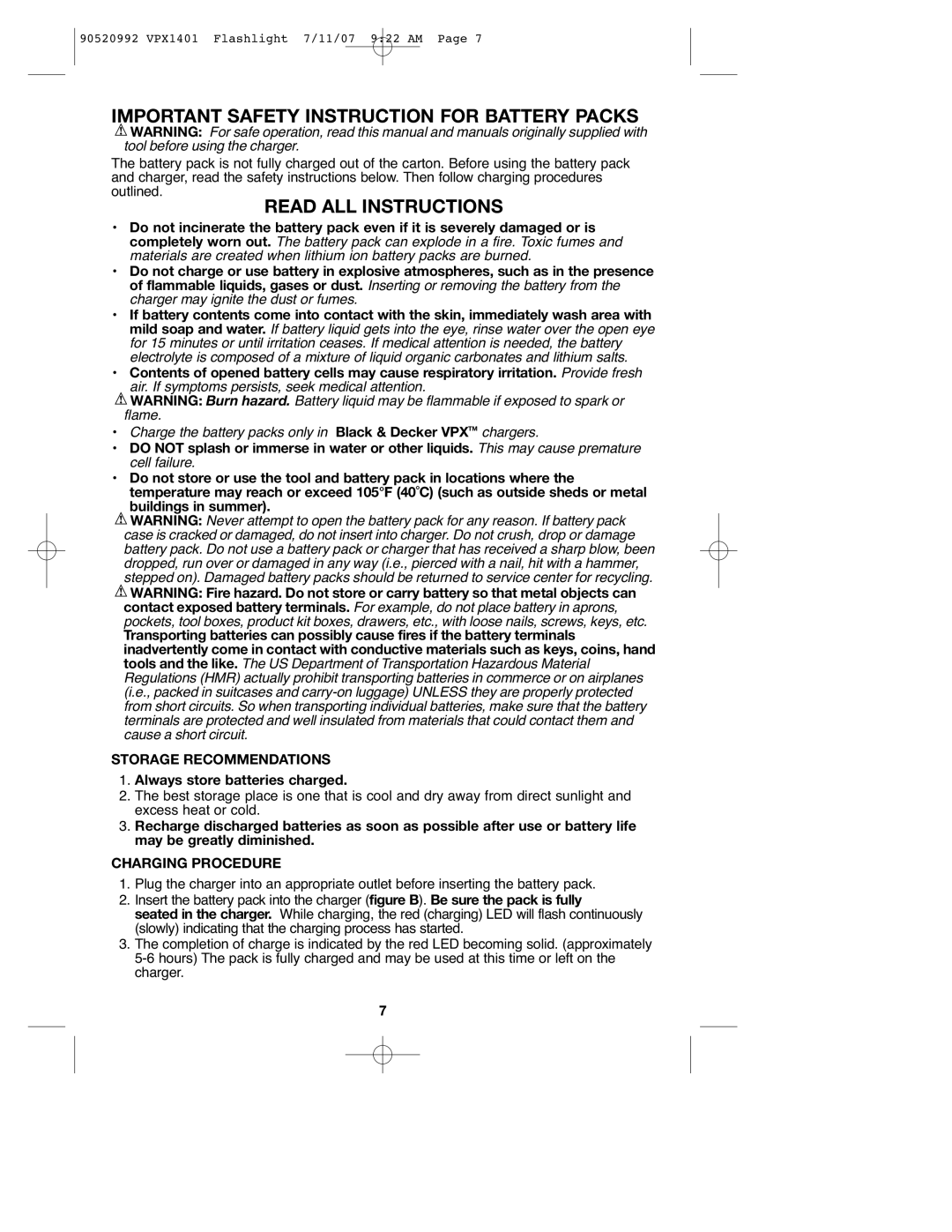
90520992 VPX1401 Flashlight 7/11/07 9:22 AM Page 7
IMPORTANT SAFETY INSTRUCTION FOR BATTERY PACKS
![]() WARNING: For safe operation, read this manual and manuals originally supplied with tool before using the charger.
WARNING: For safe operation, read this manual and manuals originally supplied with tool before using the charger.
The battery pack is not fully charged out of the carton. Before using the battery pack and charger, read the safety instructions below. Then follow charging procedures outlined.
READ ALL INSTRUCTIONS
•Do not incinerate the battery pack even if it is severely damaged or is completely worn out. The battery pack can explode in a fire. Toxic fumes and materials are created when lithium ion battery packs are burned.
•Do not charge or use battery in explosive atmospheres, such as in the presence of flammable liquids, gases or dust. Inserting or removing the battery from the charger may ignite the dust or fumes.
•If battery contents come into contact with the skin, immediately wash area with mild soap and water. If battery liquid gets into the eye, rinse water over the open eye for 15 minutes or until irritation ceases. If medical attention is needed, the battery electrolyte is composed of a mixture of liquid organic carbonates and lithium salts.
•Contents of opened battery cells may cause respiratory irritation. Provide fresh air. If symptoms persists, seek medical attention.
![]() WARNING: Burn hazard. Battery liquid may be flammable if exposed to spark or flame.
WARNING: Burn hazard. Battery liquid may be flammable if exposed to spark or flame.
•Charge the battery packs only in Black & Decker VPXTM chargers.
•DO NOT splash or immerse in water or other liquids. This may cause premature cell failure.
•Do not store or use the tool and battery pack in locations where the temperature may reach or exceed 105°F (40˚C) (such as outside sheds or metal buildings in summer).
![]() WARNING: Never attempt to open the battery pack for any reason. If battery pack case is cracked or damaged, do not insert into charger. Do not crush, drop or damage battery pack. Do not use a battery pack or charger that has received a sharp blow, been dropped, run over or damaged in any way (i.e., pierced with a nail, hit with a hammer, stepped on). Damaged battery packs should be returned to service center for recycling.
WARNING: Never attempt to open the battery pack for any reason. If battery pack case is cracked or damaged, do not insert into charger. Do not crush, drop or damage battery pack. Do not use a battery pack or charger that has received a sharp blow, been dropped, run over or damaged in any way (i.e., pierced with a nail, hit with a hammer, stepped on). Damaged battery packs should be returned to service center for recycling.
![]() WARNING: Fire hazard. Do not store or carry battery so that metal objects can contact exposed battery terminals. For example, do not place battery in aprons, pockets, tool boxes, product kit boxes, drawers, etc., with loose nails, screws, keys, etc.
WARNING: Fire hazard. Do not store or carry battery so that metal objects can contact exposed battery terminals. For example, do not place battery in aprons, pockets, tool boxes, product kit boxes, drawers, etc., with loose nails, screws, keys, etc.
Transporting batteries can possibly cause fires if the battery terminals inadvertently come in contact with conductive materials such as keys, coins, hand tools and the like. The US Department of Transportation Hazardous Material Regulations (HMR) actually prohibit transporting batteries in commerce or on airplanes (i.e., packed in suitcases and
STORAGE RECOMMENDATIONS
1.Always store batteries charged.
2.The best storage place is one that is cool and dry away from direct sunlight and excess heat or cold.
3.Recharge discharged batteries as soon as possible after use or battery life may be greatly diminished.
CHARGING PROCEDURE
1.Plug the charger into an appropriate outlet before inserting the battery pack.
2.Insert the battery pack into the charger (figure B). Be sure the pack is fully
seated in the charger. While charging, the red (charging) LED will flash continuously (slowly) indicating that the charging process has started.
3.The completion of charge is indicated by the red LED becoming solid. (approximately
7
